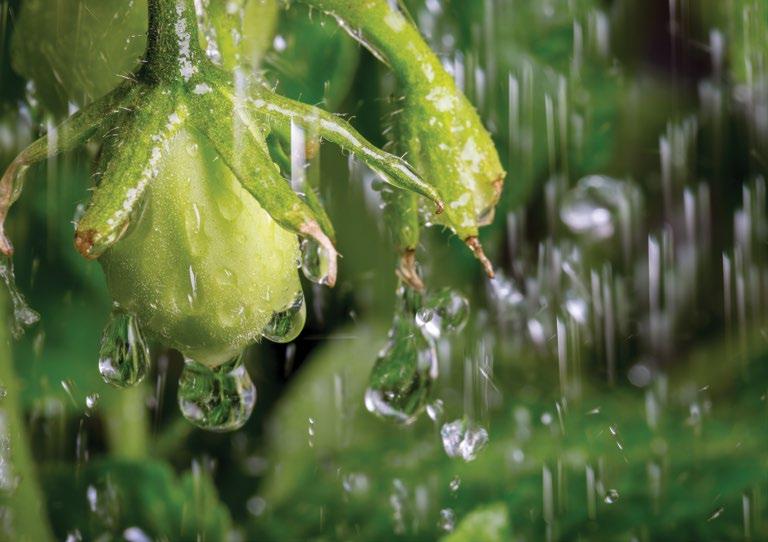
6 minute read
Tomato bacterial disease control
Tomato bacterial disease control needs more than just chemical sprays
BY VO THE TRUYEN REGIONAL DEVELOPMENT OFFICER, VEGETABLESWA
Advertisement
Three bacterial diseases are common in WA tomato fields: bacterial spot, caused by Xanthomonas campestris pv.; bacterial speck, caused by Pseudomonas syringae pv.; and bacterial canker, caused by Clavibacter michiganensis.
Prevention is the key for management of tomato bacterial diseases.
f HEAVY crop loss due to tomato bacteria diseases in Carnarvon.
Bacterial disease is present at some level every season in the two main tomato production areas in WA — North of Perth and Carnarvon.
Severe damage from these diseases may cause almost complete defoliation of the plant, low fruit set and fruit lesion disfiguration, which impact production potential and product marketability. When conditions are optimal for bacterial disease, like they were this year with rains, fog, dew and high humidity giving the bacteria a suitable environment for growth, losses in marketable yield are estimated up to 80 per cent in some fields. Several workshops on the management of tomato bacterial diseases have been organised in Wanneroo and Carnarvon by extension specialist from vegetablesWA in association with the DPIRD Areawide Management Project team.
The workshops stressed the key principle that management of tomato bacterial diseases must focus on prevention and start well before transplanting.
Unfortunately, investigation carried out by vegetablesWA extension specialists this year reveals that most WA tomato growers control bacterial diseases only by chemical spray when diseases symptoms show up. There is not enough attention paid to prevention and so far, results are not great. This article aims to bring tomato growers’ attention to the integrated diseases management approach, which once again stress the key principle:
management of tomato bacterial diseases must focus on prevention and must start well before transplanting.
Management of tomato bacterial disease
Understanding the root cause
All tomato growers I have visited in Wanneroo and in Carnarvon blame the wet weather as the cause of tomato bacterial diseases. That is not correct. Wet weather (rains, fog, dew, high humidity) makes growing environment optimal for growth of bacteria but the bacteria must be present in the first place for the disease to occur. The pathogens Inoculum
Each pathogen has a particular temperature range, in which it is at its peak rate of growth and infection (see Table 1). The pathogens multiply much more slowly outside this optimum range. Bacterial pathogens need moisture to multiply. Wet conditions in the plant canopy due to rain, fog, dew, high humidity give the bacteria a suitable environment for growth. It is worth noting that the average high of Bacterial pathogens need moisture to multiply. monthly temperature in Carnarvon range between 22–32ºC, which is like that of in Perth during tomato growing season (September to June). This means that the temperature of these tomato growing areas is optimal for the diseases to thrive as soon as the pathogens are present, and the plant canopy is wet. The four major sources of infection for these bacteria are from seeds, infected crop debris, volunteer tomato plants and contaminated equipment surfaces (i.e. farm machinery, sticks and tools). Whilst tomato growers source seeds and seedlings from registered seeds suppliers and from biosecurity accredited nurseries, the later three sources of infection have been observed existing in most of tomato farms due to growers’ poor production practices.
1 Infected crop debris:
Most tomato growers incorporate plant debris including rejected fruits into soil at the end of the season, even when they are all aware that the crop was badly infected.
TABLE 1. OPTIMUM GROWTH TEMPERATURE RANGES FOR BACTERIAL PATHOGENS OF TOMATOa .
Disease Causal organism Optimum temperature (°C)
Bacterial spot Xanthomonas campestris pv. vesicatoria 24–30
Bacterial speck Pseudomonas syringae pv. tomato 18–24
Bacterial canker Clavibacter michiganensis subsp. michiganensis 24–32
a Bacterial Diseases Of Tomato: Bacterial Spot, Bacterial Speck, Bacterial Canker. www.omafra.gov.on.ca/english/crops/facts/05-069.htm

f DISINFECTING the sticks with 0.5% chlorine solution by a tomato grower in Wanneroo.


f AVOID operations such as clipping, pruning, and picking when the plant canopy is wet is critical to avoid bacterial disease outbreaks. f THE guttation fluid of infected plant leaf.

2 Volunteer tomato plants: Since rejected fruits are left on the field, volunteer tomato plants are present in every tomato field and the chance having them growing from infected seeds of previous crop is quite high.
These volunteer tomato plants are not killed by herbicide spray as selective herbicides are used to protect cultivated tomato plants. 3 Contaminated equipment: all tomato growers use several thousand sticks to support tomato plants. There is fewer than a handful number of growers practice disinfecting the sticks. Other equipment such as clipper guns, pruning shears and wire are also rarely disinfected. Keynote: Removing these three major sources of infection is vitally important in management of tomato bacterial diseases.
Equipment may be disinfected using 1.0% chlorine solution for a minimum of 15 minutes.
Rejected fruits should be collected and buried, whilst plant debris should also be removed from the field or crop rotation and tillage undertaken before planting to reduce the risk of infection from this source. Spread
Bacteria are spread primarily by splashing water and wind-driven rain or mists produced during storms. Spread may also occur by equipment or workers in pruning operation or when plants are injured by a cultivator. Research has showed that bacteria Clavibacter michiganensis (that causes Bacterial canker), can be exuded in large numbers in the guttation fluid of infected plants1 . The fluid is spread in commercial tomato farm by workers doing clipping, pruning, and picking when the plant canopy is wet causing epidemics.
Keynote: Since splashing water and wind-driven rain or mists produced during storms are difficult to control, avoid operations such as clipping, pruning, and picking when the plant canopy is wet is critical to avoid bacterial disease outbreaks. to fail. It has been a common practice to begin an intensive copper spray program once lesions are present. Most tomato growers have experienced that starting a control program after symptoms have appeared is ineffective.
Chemicals
Fixed copper bactericides are currently the effective registered control products for bacterial disease on tomatoes2. The activity of fixed copper on the bacteria is due to free copper ions in the spray solution3 . It takes an incredibly high density of bacterial cells on the plant before symptoms are visible, and efforts to eradicate bacteria when they are at such high population levels are destined
Depending on the severity, spray intervals of seven days or less may be required. Good spray coverage and the use of recommended rates are also very important. Bacteria is spread primarily by splashing water and wind-driven rain. Many research trials across North America have shown that tank-mixing mancozeb with copper enhances bacterial disease control. Bacteria reproduce very quickly. Although foliar sprays may clean the surface bacteria from a leaf, within a short period of time the bacteria inside the leaf and those not controlled
2 https://portal.apvma.gov.au/pubcris?p_auth=5mxYGxMG&p_p_id=pubcrisportlet_WAR_ pubcrisportlet&p_p_lifecycle=1&p_p_state=normal&p_p_mode=view&p_p_col_id=column-1&p_p_col_ pos=2&p_p_col_count=4&_pubcrisportlet_WAR_pubcrisportlet_javax.portlet.action=search 3 www.omafra.gov.on.ca/english/crops/facts/05-069.htm on the foliage (due to incomplete spray coverage) can build up population levels that can cause an outbreak. Thus, Fixed copper bactericides suspend rather than control the diseases.
Keynote: The recommendations in this article outline a preventative program and must be followed closely to be effective. If preventative copper applications are used at transplant, relatively few sprays are required.
MORE INFORMATION
Truyen Vo, Regional Development Officer, phone (08) 9486 7515, 0457 457 559 or email truyen.vo@vegetableswa.com.au
Department of Primary Industries and Regional Development
Save the date
What: 2021 Western Australian
Horticulture Update
(WAHU2021) Theme: Sustainable and resilient: the future of WA horticulture When: Thursday, 4 November 2021 – Conference and sundowner Friday, 5 November 2021 – Farm tour and site visit Where: Perth, WA

Photo supplied by WA Potatoes. Photographer – Anton Blume
956/21










